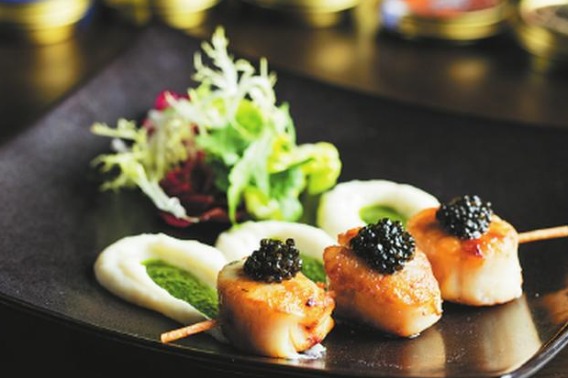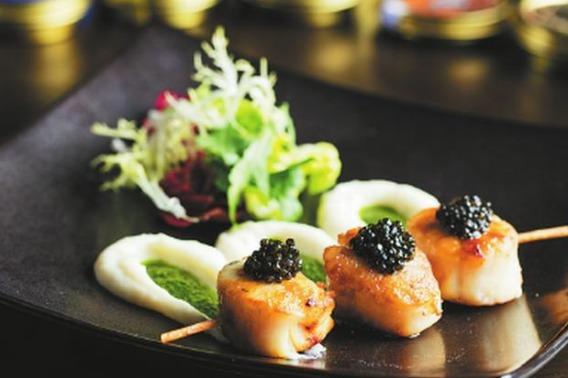
BEIJING -- Spring has come. The 700 metric tonsne of sturgeon farmed in East China's Qiandaohu Lake by Kaluga Queen are expected to spawn and produce one of the world's most expensive gourmet delicacies - caviar.
Weighing 10 to 12 percent of a fully mature sturgeon, which is usually 7 to 15 years old depending on the species, these unfertilized roe are to be retailed at a maximum of 180 yuan (28.6 U.S. dollars) per gram, more than half of the price of gold.
Kaluga Queen is the world's largest caviar producer, breeding sturgeon in the 573-square-kilometer lake in Zhejiang province. Though most of its caviar products are for export, the company is trying to whet the appetite of 1.4 billion Chinese for the "food of the czars" in the coming years.
Founded in 2003 by several former aquaculture researchers from Beijing, Kaluga Queen, named after the sturgeon species dwelling in Northeast China's Heilongjiang province, surpassed Italy's Agroittica Lombarda SpA as the world's biggest producer of caviar in 2015 with its production reaching 45 tonnes.
Over the years, its caviar has found its way into the first-class cabins of Lufthansa and 22 of the 28 Michelin three-star restaurants in France. In 2016, it was served at the banquet for world leaders at the G20 Summit in Hangzhou, capital of Zhejiang province.
In 2017, the Quzhou-based company's output reached 70 tons, representing around one-third of the global total and consolidated sales of 207 million yuan. Almost 90 percent of its output is exported to Europe, the Middle East and the United States.
But the company hopes that over the next five years, the situation will reverse, with Chinese citizens consuming up to 90 percent of the total, said Xia Yongtao, deputy general manager of Kaluga Queen, who admitted it might be "an unreachable dream".
If the "dream" is realized, however, the company's revenue and profit will surge, as selling domestically means cutting out middlemen and benefiting directly from consumers.
"Unlike wine or other industries that are seeing stagnant if not negative growth in Western markets today, the supply of caviar is largely outnumbered by demand globally. But we still believe the mine of the black gold lies in China," said Xia, who has been with the company since its founding.
Xia and Wang Bing, founder of the company, were part of a research team funded by the Chinese Academy of Fishery Sciences that helped make sturgeon farming possible in the late 1990s.
Li Jun, director of the China Sturgeon Association, gave a more modest prediction. He estimates that by 2020, China will consume 100 tonnes of caviar every year, accounting for one-third of the world's total. Caviar will be an accessible treat for not only the wealthy, but also the middle-income group, he added.
The association is formed by dozens of companies involved in the business, including sturgeon farming, processing and feed manufacturing. Li noted that there are no more than five companies in China capable of managing a complete supply chain of caviar, which starts from sturgeon breeding and concludes with the final packaging of the delicate roe.
The consumption of caviar began to pick up in China around 2012, but the bud was nipped the next year due to the anti-graft campaign introduced by the central authorities, which prohibits luxury dining and gift giving with public money.
In 2016, as the fine dining scene gradually revived and Michelin launched its first restaurant review on the Chinese mainland, piquing keen interest in restaurants at an average cost of 300 yuan and above, caviar consumption started to gain momentum and soared at a growth rate of 50 percent annually, according to the association.
Traditionally, caviar production depends mostly on wild fishing by countries surrounding the Caspian Sea, primarily Iran and Russia. According to a report by the Food and Agriculture Organization of the United Nations, the worldwide catch of sturgeon reached its peak in 1977 at 32,078 tonsne, which translated into 2,000 tonnes of caviar.
Since the dissolution of the Soviet Union in 1991, however, global caviar supply has undergone a drastic decline. The long-established sturgeon and caviar management system gradually weakened, resulting in rampant illegal fishing and habitat degradation.
Today, global caviar production remains steady at around 200 tonnes a year and largely comes from artificial breeding, as several sturgeon species have been classified as endangered since 2000. The classification resulted in a ban on wild fishing and at the same time triggered commercial breeding to boom.
"It's a lucrative business, but also one that poor people cannot afford to start and rich people disdain to join, considering the investment time required for the fish's maturity and egg production," Xia said.
With an initial investment of around 6 million yuan, mainly from several founding partners, Kaluga Queen harvested its first batch of caviar in 2006 and started to widely market it the following year, when China's food-safety problem was at its peak.
"At first, we were treated with such bias that once they heard it's "Made-in-China", people would turn us down immediately without opening the can and having a taste," Xia recalled.
After attaining several top winner titles at caviar blind tasting events and exhibitions with its high quality, Kaluga Queen had its first breakthrough, becoming the supplier of Lufthansa's first-class cabins in 2011.
Today, the company is expected to keep a double-digit growth rate, with production reaching 100 tonnes in 2019. While the growth is seen evenly in both retail and partnership with fine dining restaurants and luxury hotels, Xia thinks there will be growing potential in retail as more Chinese consumers get their first bite of the roe.
"Our strategy is to work with as many restaurants as possible in China, turning them into our tasting rooms to deliver our roes as extensively as possible. Once the foundation is built, we will reduce the retail price, say by 5 percent, to get millions of consumers hooked," he said.
Kaluga Queen is now the exclusive supplier of caviar for around 500 restaurants and hotels in China, but most of them are Western-style restaurants.
"The way and amount of caviar being used in Chinese cuisines currently only represent a tip of the iceberg," said Xia, whose team is now working closely with Chinese fine dining restaurants including Da Dong, the roast duck chain, and Xin Rong Ji, the seafood chain, to develop new dishes using caviar.
Meanwhile, the company's research and development team is also working to use other parts of the fish, including sturgeon fillets, marrows and skin for leather products, though caviar will remain the chief money-spinner for the company, Xia added. (Source: China Daily)




 A single purchase
A single purchase









